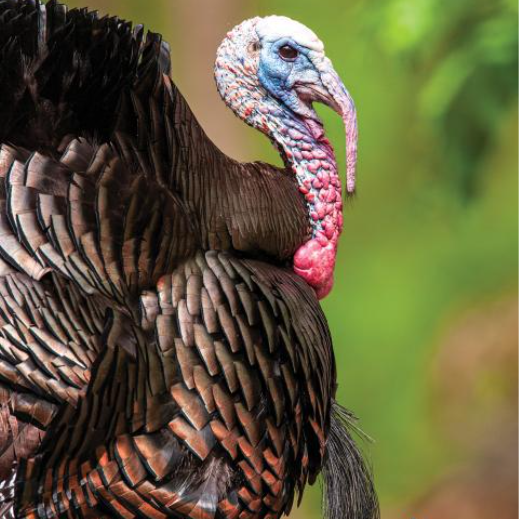Spring Morels

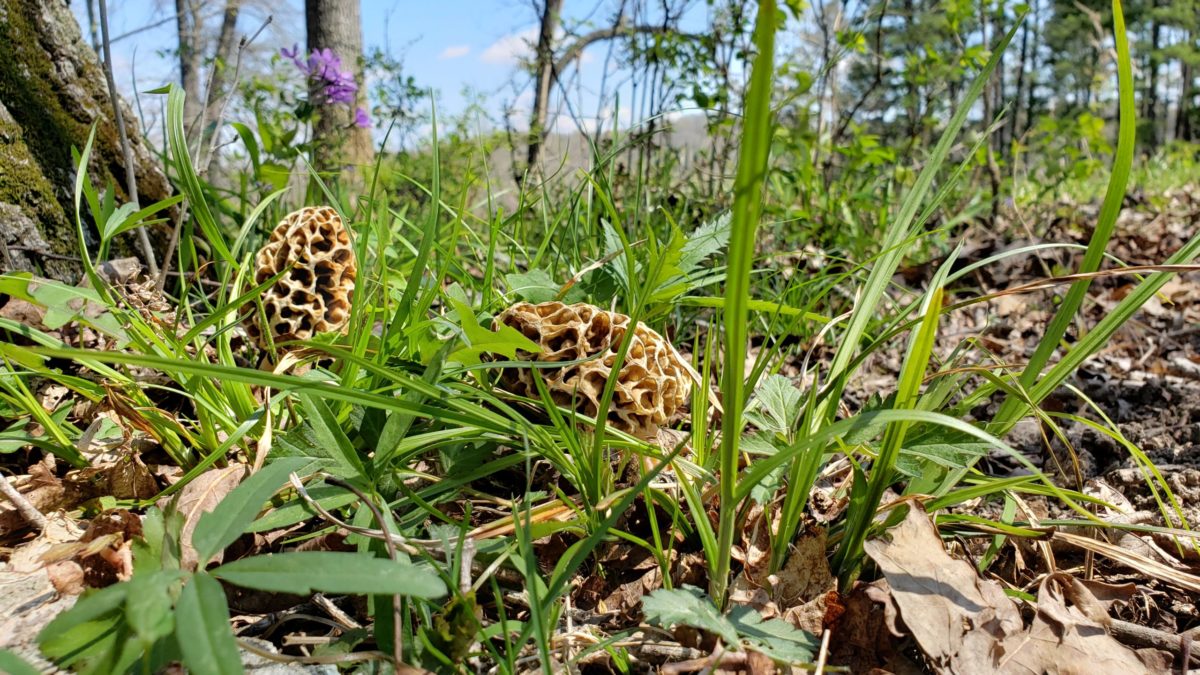
Spring Morels
Originally published in the Conservation Federation magazine, March 2021 vol 82 no 2.
Take a moment to think of a rewarding outdoor activity anyone can get involved in. Does that activity require any special equipment or expertise? Last year brought many newcomers into the great outdoors for many reasons, whether to escape from endless hours of screen time or to find new productive forms of entertainment. Deer and waterfowl seasons closed a little while ago and the opening of spring turkey season marks the short window of the year of my favorite season, morel mushrooms. Morels are a genus of fungi (Morchella) that come onto the scene for about a month in Missouri. Their season fluctuates with temperature, humidity, and rainfall, but there are general things to look for to know it’s that time. Spring turkey season cuts off every day at 1pm. Every opening weekend (April 19 this year), my cousin and I will hunt turkeys in the morning and morels in the afternoon; that weekend is nearly a sure bet for finding morels. The old-timers say to look when the oak leaves are as big as a squirrel’s ear and believe it or not, that timing works out pretty well too!
But where do you start?
Do you jump out into the woods and start grabbing and eating wild mushrooms? By no means! First and foremost, when foraging, always positively identify the species. Morels are pretty easy to ID once you learn and know them, but they do have some dangerous lookalikes. True morels will have a loosely conical shape, a pitted cap (the top part of the mushroom) resembling a sponge or honeycomb, and a hollow stem (see photo). There are arguably four species of true morels in Missouri, the American morel aka “yellows” (M. americana), the halffree morel (M. punctipes), black morels (M. angusticeps), and hickory chicks aka “grays” (M. diminutiva). If you are ever concerned about what you have, take it to a regional MDC office or nature center, or email them a picture and ask before you eat. I’m a part of several great Facebook groups in Missouri for mushroom identification and morels specifically, but it boils down to this, don’t eat it if you’re not 100% certain what it is. The second rule of foraging is to try a small amount of the food and wait before you eat a full serving. Some people are more sensitive to wild food than others, so just because some people eat a mushroom doesn’t mean you will be able to do so. Ok, those are all my disclaimers; let’s dive into morels.
Morels are generally associated with the roots of trees. The mushroom is simply the fungus’s fruiting body, which spreads its spores, similar to how an apple spreads seeds for the apple tree. The majority of the fungus lies underground. Their relationship with trees is not fully understood; they may be parasitic on the trees or they may help provide nutrients for the tree that it could not gather from the soil on its own. It seems that when one of these trees dies, this fungus “abandons ship,” so to speak, and sends out its fruiting bodies before it dies. Dying trees seem to be great places to find morels. But which species of tree? Don’t worry, we’ll get there in a moment, we have to cover the habitat first.
Many people have their favorite places to find morels, hillsides, and creek bottoms seem to be the main arguing points, but be assured, no ‘shroomer will reveal their spots. People have been known to take their “honey hole” locations to the grave, never revealing them to their own family! These people are serious. For someone new to the sport, I recommend creek bottoms. My experience has shown that low-lying areas near year ’round streams and rivers seem to be the best spots. Start scouting (looking for) spots now. Conservation areas and state parks can be great places, but you’ll have to beat the competition. Be sure to follow guidelines and regulations at public areas and know the rules before you go. E-scouting is also a great way to look for somewhere to hunt morels. A new smartphone application on the scene is On-X, but you can get by just fine with a free app like Google Maps. Look for low, flat areas with sandy soil near streams.
Now for the trees.
You may be thinking, I don’t know how to identify trees, I’m here to tell you, you can do it! You need to know only 5 main tree types with which morels associate. In order of my personal most success, those are American elm (Ulmus americana), ash (Fraxinus), black cherry (Prunus serotina), American sycamore (Platanus occidentalis), and eastern redcedar (Juniperus virginiana). The best way to recognize these trees in the early spring is by their bark, and luckily, they’re all fairly distinct. I will go through each species/group below. Be sure to refer to the photos of each.
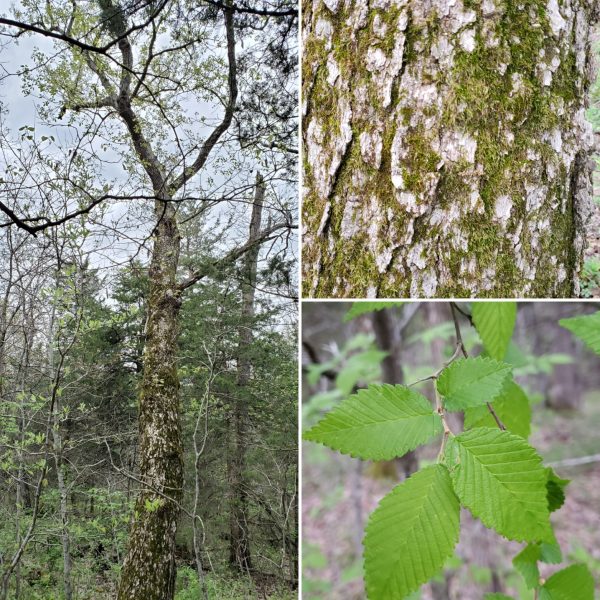
Figure 1: American Elm
American Elm: There are three common elm species within the state, but the American elm (Figure 1) is the easiest to recognize and seems to produce the most morels for me. I usually spot this tree in the distance by the abundance of green moss growing on light-colored bark. Its bark is scaly with the areas between the scales being the same light color. American elm is one of the earliest trees to begin putting on leaves and almost immediately drops its seeds first thing in the spring. The seeds are called samaras and look a bit like an over-easy egg, flat and circular with a raised dark area surrounded by a thin disk. Sometimes I key in on the seeds on the ground or even fall before seeing the tree itself.
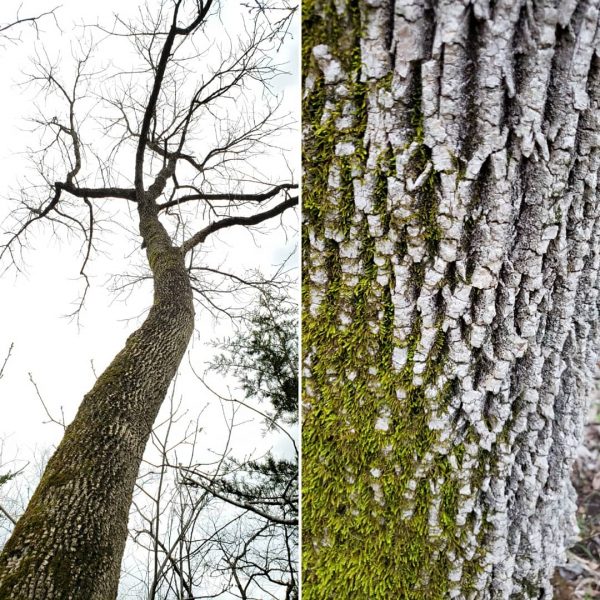
Figure 2: Ash
Ash: We have six common species of ash in Missouri, for our purposes, which species does not seem to be relevant. Ash is also easy to identify at a distance from its deeply-furrowed bark (Figure 2). They have light-colored ridges with dark-colored valleys running vertically on the trunk. Like the elm, moss seems to favor the tree, but unlike elm, it typically does not cover the tree on every side of the trunk. The bark ridges form a distinctive pattern, seemingly crisscrossing one another into “X’s.”

Figure 3: Black Cherry
Black Cherry: Black cherry bark can be best described as scaly (Figure 3). Its scales are larger than the American elm and appear as two-inch or so square-ish blocks that are light gray with dark furrows between them. How to spot them from far away is their trunks are usually darker than the other trees around them. These trees are also some of the first to leaf out and will likely be nearing flowering. Cherry leaves are oval and lightly toothed. Later in the spring, the cherries on these trees are edible but somewhat bitter.
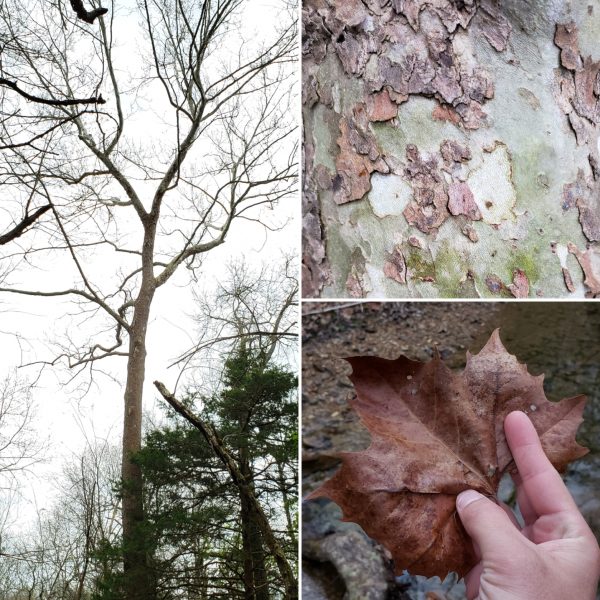
Figure 4: American Sycamore
American Sycamore: This species can be easily recognized even from the highway. Toward the tree’s base, the bark of the American sycamore is brown and flakes off with a light touch to reveal a light green or white smooth under bark (Figure 4). Near the canopy, most of this outer bark has flaked off to reveal stark white main branches. The forest floor beneath these trees will likely be covered in their leaves from the previous year, like the maple leaf on the Canadian flag.
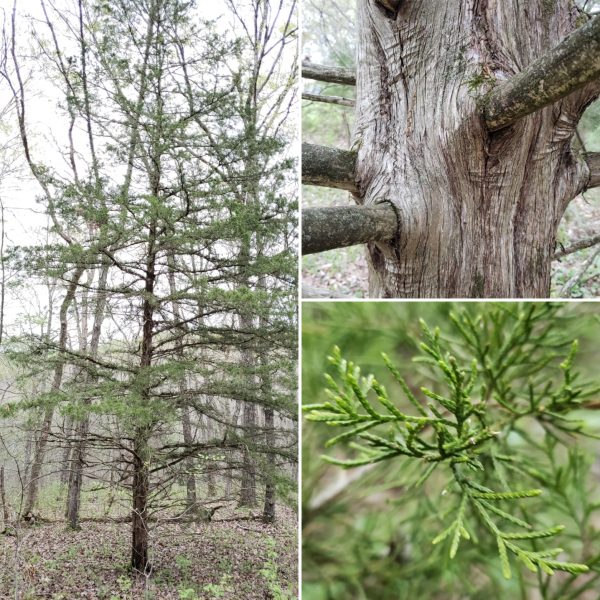
Figure 5: Eastern Redcedar
Eastern Redcedar: Cedar is a coniferous tree that remains green all year long. Its leaves are modified into small overlapping scales (Figure 5). This tree’s outer bark usually has long vertical lines that can be pulled off in fibrous strips (which can be woven into cordage or used as tinder to start a fire). Lower branches on this tree are usually dead but still attached to the trunk.

There you have it, the basics of morel mushroom hunting. Most folks carry a mesh bag to collect their morels as they believe that it helps spread the spores while you walk and keeps the mushrooms fresh. Once you get your mushrooms home, most people soak them in saltwater to rid them off the bugs and little critters living in them. Others swear against water with salt in it and say a simple water soak is fine. After their soak, rinse and they are ready to be added to your favorite recipe, sauteed, or fried as most of us enjoy them. Some folks even dry them or freeze them to use later in the year (ours usually get eaten right away). Practice makes perfect! Go out and study your trees now, they won’t look too much different come spring. Search for a spot. A good tip is to look at many photos of morels to create a search image. And pretty soon you’ll be dreaming of morels.
Colton Zirkle
Education and Communications Coordinator
Conservation Federation of Missouri
All photos by the author.

